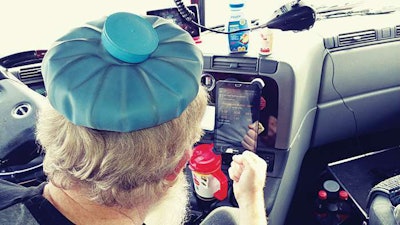
Entertainment-niche team owner-operators Nick and Kim Holley had some use of electronic logging devices in their past when their current leasing carrier dropped Omnitracs’ XRS ELD setup on them late last year in advance of the ELD mandate’s Dec. 18 deadline. Their XRS unit is of the BYOD (“bring your own device”) type, paired with a dedicated tablet that is the user interface.
SOLVING THE BLUETOOTH CONNECTION ISSUE
Based on Overdrive polling, drivers’ most common problem with ELDs is dropped connections between a BYOD (“bring your own device,” typically a phone or tablet) and the device’s ECM plugin portion.
Given wide pre-mandate use of smartphone-based logging programs by owner-operators, many have migrated to ELDs with BYOD systems that often connect an ECM plug-in device to the user interface on a phone or tablet program via Bluetooth, but occasionally the connection could be made through the cloud via a cellular connection or locally over Wi-Fi.
A year ago, Overdrive reported on the experience of small fleet DC Transport’s owner-operators during their beginning run with the J.J. Keller Encompass system ELD, where dropped Bluetooth connections were an issue from time to time.
In some systems, dropped connections can cause unassigned-driving events to mount for system operators responsible for reconciling multiple driver accounts, not to mention presenting issues of log currency for drivers during roadside inspections.
Katie Cullen, who oversees the ELD transition at Chicago-area DC Transport, wrote in later with her dropped-connection solution: Dedicating tablets to each owner-operator’s truck for logging.
Previously, drivers had been using their phones exclusively to log, keeping paper log backups as the company worked into the system. Cullen now attributes the dropped-connection issue to use of the phones, she says. Drops occurred when drivers “were making phone calls or running other apps at the same time, such as playing music via Bluetooth.”
Today, she says, “We have switched all our drivers over to dedicated tablets.” Without interfering applications in use, “we have had no Bluetooth connectivity issues.”
Another solution to dropped local connections is to run a device wired to the ECM directly. The KeepTruckin BYOD ELD provider last year introduced a USB-connection alternative to its otherwise Bluetooth-paired system. The USB option, the company says, allows for speedier data transfer and a hardwired solution that also delivers continuous battery charging to the phone/tablet in the ELD pair.
The device is normally “pretty flawless,” Kim says, “but set up as a team, there is a plethora of problems.” In her 42 years of marriage to her husband, “I’ve never heard him swear, but since we put this system in, I can’t tell you how many times I’ve heard him.”
Nick Holley, no doubt, is far from alone in frustration over misbehaving ELDs. Though plenty of new ELD users report no significant issues, others have experienced problems running the gamut from software glitches to dropped Bluetooth connections in other BYOD-type systems to unresponsive customer service departments.
KeepTruckin experienced a service outage on day one of the mandate that made news, along with a brief problem with Omnitracs users’ access to its back-office portal to logs data. The surge of new users of both platforms appears to have played a role.

J.J. Keller’s Encompass ELD users were granted a temporary mandate exemption through the end of February by the Federal Motor Carrier Safety Administration after the company requested it. The issue at hand was a flaw in wireless data-transfer functionality at roadside that rendered that aspect of their ELDs unworkable. J.J. Keller reported in February that the problem had been resolved.
An unnamed reader tipped Overdrive to a server issue that impacted functionality for some Teletrac Navman users in recent weeks and resulted in two units in his 14-truck fleet needing replacement. The reader noted unresponsive in-cab units among others in the fleet, and no recorded mileage from several units for the better part of a week and more as the server-migration issue continued.
The problems were resolved in about a week, Teletrac Navman spokesperson Stephanie Kacoyanis said.
A different Teletrac Navman small fleet user wrote Overdrive on March 27 about some similar issues, however, noting he had been waiting for some replacement equipment from them for one truck since December 8, 2017, and had another unit that hadn’t reported to the Teletrac Navman system for 80 days or more. All in all, the trucker had six customer-support tickets open with the company, he said.
“This industry is now dependent on their, and other suppliers’, equipment to function,” he went on. “We have been given very specific guidelines to log our hours, and told it is mandatory we comply. It only makes sense to ensure the products we are now forced to use remain in compliance as well, don’t you think?”
In the wake of some of these and similar issues, FMCSA updated its Frequently Asked Questions at its ELD website that appeared to be a tacit acknowledgement that some ELD software just wasn’t up to snuff. FMCSA previously had said prior-generation automatic onboard recording device (AOBRD) e-logs were off-limits to carriers not using them prior to Dec. 18, 2017. Now it says that AOBRD software running on newly adopted ELD-capable hardware is admissable through Dec. 16, 2019, at least for fleets that put AOBRDs in use before the 2017 mandate deadline.
On March 19, an email went out to ELD makers warning them that state field inspectors were “encountering some devices that are malfunctioning or not compliant with the ELD rule. These devices are being reported to FMCSA for investigation, which starts FMCSA’s formal process for notifying vendors. This process could result in the removal of a device from FMCSA’s list of registered, self-certified devices if the reported issues are not satisfactorily resolved.”
While FMCSA did not respond in time for this report to questions from Overdrive about the depth and breadth of the agency’s device investigations, it’s clear at least they’re aware of some of the issues truckers are experiencing.
Among team-related problems experienced by the Holleys was an apparent inability to switch drivers in their system when the current driver is logged off-duty. It was an annoyance when the team stopped, say, to eat together, then make a driver change.
But more importantly, the Holleys say, is a glitch that stems from the system’s design. If you go off-duty and turn over control of the vehicle to another driver, Nick says, “and you’re off-duty for more than two hours as the truck is running down the road, the system automatically puts you back on-duty,” driving.
Safety personnel at the company referenced guidance that limits time “off-duty in the jump seat” to two hours as explanation. The automatic switch to the drive line is the system’s way of attempting to automatically account for that regulatory limitation as the vehicle moves, says Tom Cuthbertson, Omnitracs’ vice president of regulatory compliance.
It’s clearly a major annoyance for teams, and one that Omnitracs customer support has acknowledged as an issue from time to time, Nick Holley adds.
Cuthbertson says preventing this from happening could be simply a matter of the off-duty driver moving to the sleeper berth line before the two hours are up, or going sleeper to begin when he or she goes off-duty, depending on the circumstances. Cuthbertson adds that it sounds like the Holleys are using the grandfathered AOBRD version of the XRS system. To avoid the necessity of making edits on the back end, it’s programmed to make automatic changes of this kind.
In the ELD version, as per the functionality specified in the mandate rule, drivers have more control of duty status changes. With the ELD, rather than automatically move the off-duty driver back to on-duty, instead the driver gets a warning ahead of the end of the two-hour period, Cuthbertson says.
Paul Bazyldo, posting in the Overdrive’s Trucking Pro Facebook group, noted his ELD’s required GPS functionality simply never worked. The “manufacturer finally had me send the unit back,” he wrote, during all of which he petitioned FMCSA for more time on paper logs as the manufacturer addressed the issues. The ELD mandate allows eight days to replace a malfunctioning unit. If delays beyond that time period are expected, additional time must be requested through a division office.
Bazyldo says the ELD has done nothing to “make the task of documenting [hours of service] easier by any means. … In fact, due to the amount of time I’ve spent trying to get the unit to work, it actually removes value from my single-truck operation on just about a daily basis.”
The Owner-Operator Independent Drivers Association requested a congressional hearing last month on ELDs. OOIDA Acting President Todd Spencer wrote that members have experienced “several vendor-wide systems failures, faulty GPS tracking, inaccurate recording of duty statuses, engine disablements, speed irregularities, abysmal customer service from manufacturers, a worsening truck parking crisis” and more.
 Nick and Kim Holley haul in a 2010 Freightliner Coronado. Their “furniture lives in Texas,” says Kim, while their home is mostly on the road.
Nick and Kim Holley haul in a 2010 Freightliner Coronado. Their “furniture lives in Texas,” says Kim, while their home is mostly on the road.Owner-operators and small-fleet owners who’ve not experienced such equipment issues often disagree with Bazyldo’s take on ELDs. They point to improved rates in the wake of the mandate, among other things, as clear positives.
Leander Richmond of Michigan was among small fleet owners who waited until the Dec. 18 deadline to put ELDs into operation, “hoping and praying that somewhere things would break” against it. He also expected rates improvements, “and that has been realized.”
With well-functioning Omnitracs units in his eight Freightliner Cascadias, Eagle Express owner Richmond also references a generally positive experience working with Wired Truck, an Omnitracs reseller. “They had a bumpy rollout, but they were on top of every issue,” he says. “They worked around the clock to make sure we got everything up and rolling.”
For Henry Albert, Overdrive’s 2007 Trucker of the Year, the Continental VDO RoadLog unit he’s adopted has been trouble-free. RoadLog is alone among ELDs in not relying at least in part on an internet connection.
Owner-op Dean Carnahan, commenting on the same post as Bazyldo, said he’d experienced no problems with his KeepTruckin ELD setup.
For small fleets, ELDs could help pacify brokers
Eagle Express owner Leander Richmond’s Omnitracs onboard dedicated-type ELDs have delivered his eight-truck operation a capability that could solve a particular problem — increasingly “ridiculous” proof-of-delivery expectations among brokerages. Some brokers have attempted to make it a contract stipulation that the carrier will be required to send proof of delivery within an hour of offload, he says, or lose all claim to payment for that load.
Sound outrageous? Let’s just say he doesn’t sign those contracts. Nonetheless, managing incoming requests for POD paperwork from brokers has gotten out of hand, though Eagle Express typically invoices within a week.
What Richmond has begun doing is geofencing customer locations. The Omnitracs system is “able to send an email to the broker when the load comes in and breaks the plane going in and going out,” Richmond says.
“My thinking is they can’t argue about the time we got there and the time we left” — and it could tamp down on some of the POD expectations. “If I have to take three calls a day” looking for PODs, that “does take time.” A more automated invoicing process with POD could well be the result one day.
Bennett Motor Express leased operator Jerry Boyd was among those “horrified” about the prospect of switching to e-logs, he says. Now, “I wish there’d been e-logs the day I started driving a truck.” Part of his reasoning is that he experiences much more leverage over shippers and receivers who otherwise might waste his time.
He’s been running e-logs about a year, with plenty of time to work out the kinks before Dec. 18. He’s using Rand McNally’s BYOD-style HD100 ECM plug-in, paired with a tablet mostly dedicated to the logging task. “It costs you a little money,” he says, but he generally enjoys the convenience and simplicity of the device, which has had few problems. There are times when the device is out of range of cell towers that “it’s a little aggravating.”
Boyd, like other operators, however, wants hours of service changes to help lessen the pain of the new technology by freeing operators to run with greater flexibility and fewer limitations. Boyd sees the cumulative 70 hours in eight days limit as onerous. “If you don’t work but 11 hours a day,” he says, “I don’t see where the 70” should be a limitation.
Landstar-leased operator Rick Ash says he was told by the safety department that he violated his 70 at the tail end of a week in which two Omnitracs service outages put his ELD down. During each event, he was robbed of any effective window into his cumulative limits.
His problems began on a Monday. He’d been on duty six hours as he finished unloading in Montgomery, Alabama, and had driven two hours. As he rolled out, however, his ELD told him he had just two hours of driving left.
Conversations with the logs department told him the Omnitracs system had crashed and showed no update from his unit since Sunday. He says he was told not to worry about violations because “you won’t be seeing accurate numbers” on the in-cab unit.
Later in the week, a similar thing happened. The logs department reassured him he had plenty time. Just before he was planning to shut down, however, safety called to say he was running beyond his cumulative limits.
“That could have been true,” he says, but by that point he’d lost confidence in the entire record. Now he’s got a violation in the company’s system that the safety department will not remove, he says. He’s unsure how that will bear on his lease status, if at all.
A Landstar spokesperson noted “the company does identify log violations and, depending on the violation, may require remediation training or take other steps to address the violation.”
Kim and Nick Holley, too, have experienced intra-fleet conflict since moving to ELDs, when an outage basically rendered the log nonfunctional, according to an email from the office. The message, essentially: “Try not to do anything until we get this taken care of,” Kim says. “On one side, dispatch is saying get there. Safety is saying wait.”
So Nick “whipped out his laptop” logging program, Kim says, and delivered. “When we got to the location, we were able to get hold of the Omnitracs people,” whose tech acknowledged the XRS “has a problem with teams.”
Landstar says its owner-operators’ ELDs “include functionality in the event of a service outage or disruption that provides that, as soon as the ELD resumes service, it is supposed to ‘catch up’ or track from where it left off in order to accurately reflect the hours of service for that operator.”
But Ash says that the next time he has an ELD technical problem, he’s going to do what Nick did and “reach for my paper logs” to keep as accurate a record as possible, which FMCSA itself has advised. In the event of a totally malfunctioning unit, a data download from the unit or a cloud storage account – or an email from dispatch – could fulfill carrying the previous seven days’ records.
Download the full ELD Buyers’ Guide

Click here to download the full version of the Overdrive ELD Buyers’ Guide, updated with how your business can choose an ELD for your business.
Cuthbertson emphasizes that Omnitracs’ onboard units enable an “offline login” mode that should be available during outages so that a driver can retrieve the prior seven days’ records and minimize use of paper logs.
On issues of customer support, Cuthbertson recognizes the change that going “from paper to electronic” represents. “That’s why we put the help button on all the screens” in their devices and invested in training with local-support companies such as Wired Truck.
But no small amount of frustration with the change continues, nonetheless. Kim Holley says she sees tension mounting among her fellow drivers: “We understand the time crunch they’re feeling.” She witnessed a shouting match over a tight through-lane in a Flying J parking lot as operators headed in opposite directions hit an impasse.
“I think that the tension that drivers are under right now is insane,” she says. “It’s very intrusive into our lives.” The tension is pushing good people out of the business, she believes.
In spite of his generally positive experience with ELDs, small-fleet owner Richmond also says he still has “drivers I have to talk off the ledge” of quitting. What he tells them: “You just have to change your mindset and your expectations, and you’ll be fine. You can’t drive these trucks like you’re on paper logs anymore.”









